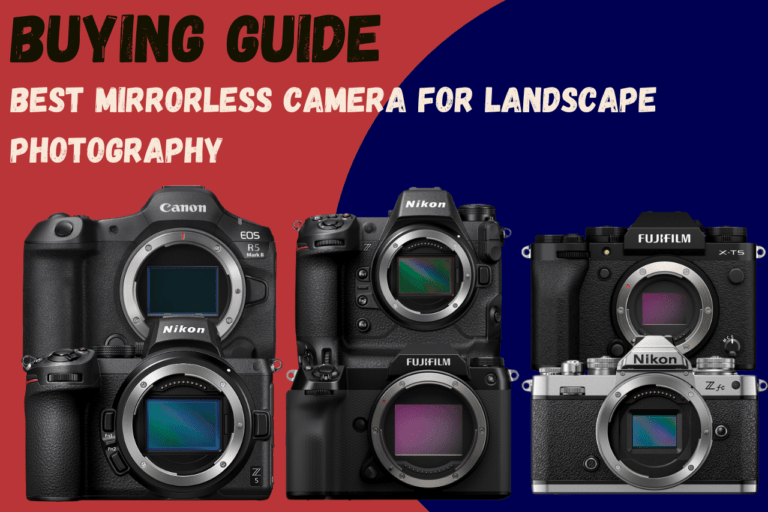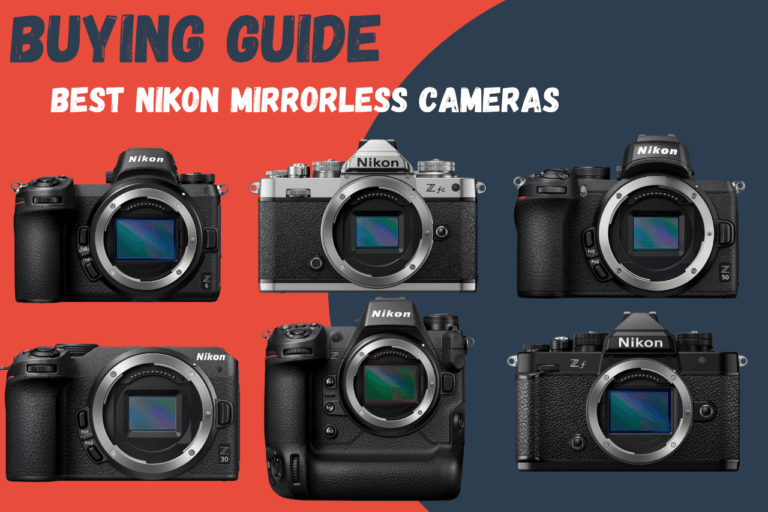Mirrorless cameras are getting more popular every year. With their impressive sensor performance, rapid autofocus, and versatile video capabilities, these cameras are the future of both photography and videography.
Whether you’re a street photographer, an aspiring vlogger, or a seasoned hobbyist ready to upgrade, there is a mirrorless camera for you. This is why in this guide, I will go over the best mirrorless cameras under $2000.
What Do I Do With My DSLR Lenses?
I should mention that one of the very understandable fears you might have is lenses. I know that if you already invested in DSLR lenses, and you are now thinking of switching to the mirrorless system, you are probably asking yourself: What do I do with them?
Well, no worries. Using adapters, you can easily adapt your DSLR lenses to a mirrorless body, and everything you need to do is explained in a separate article.
So, let’s get started!
The Best Mirrorless Cameras under $2000: Our Top 21 Picks

The ratings you see next to each camera are based on extensive research and comparison with the help of sites like Versus and Camera Decision.
However, while they help order these cameras, they don’t reflect everything. We all have a special relationship with our cameras and the first brand we purchased from; no number can show that. So please remember that these numbers are just for illustration purposes.
- OM System OM‑3 (90 points)
- Sony a7 III (85 points)
- Nikon Z6 III (82 points)
- Canon EOS R6 II (82 points)
- Canon EOS R8 (82 points)
- Nikon Z7 II (82 points)
- Nikon Zf (79 points)
- Sony a6700 (78 points)
- Fujifilm X‑T5 (77 points)
- Fujifilm X‑T50 (76 points)
- Fujifilm X‑S20 (74 points)
- Sony a7C II (73 points)
- Fujifilm X100VI (73 points)
- Panasonic Lumix S5 II (71 points)
- Nikon Z50 II (70 points)
- Sony Alpha ZV‑E1 (69 points)
- Sony a6600 (69 points)
- Fujifilm X‑M5 (66 points)
- Nikon Z fc (64 points)
- Nikon Z5 (62 points)
- Sigma fp (47 points)
OM System OM-3
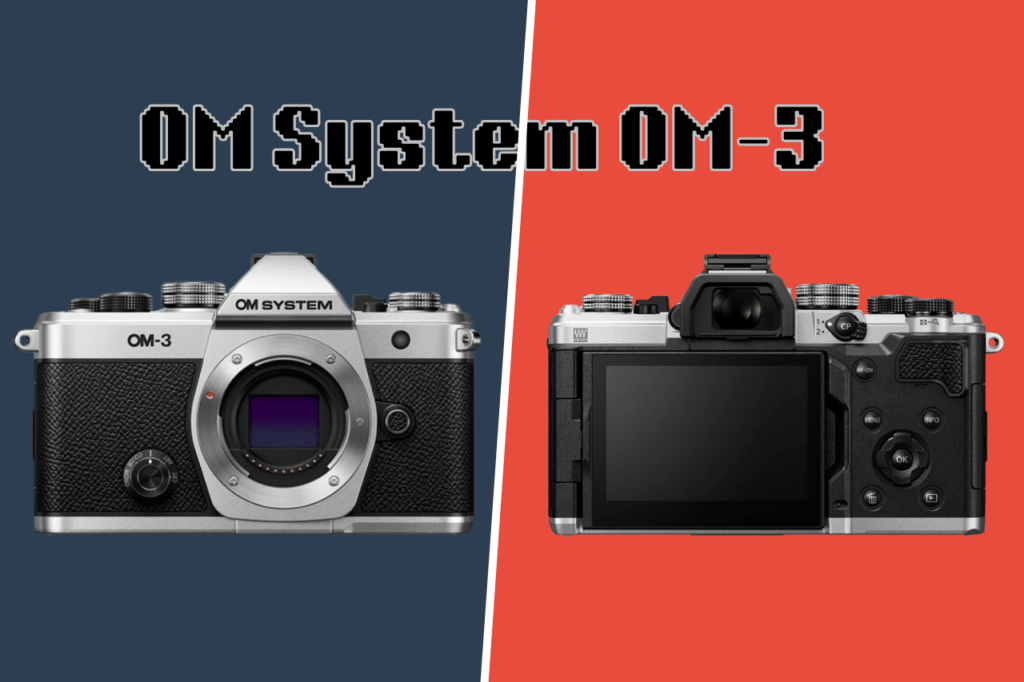
Sensor & Image Quality
- Sensor: 20.37-megapixel stacked BSI Live MOS sensor
- Processor: TruePic X Image Processor
Autofocus & Burst Speed
- Autofocus: 1053-point cross-type on-chip phase detection Quad Pixel AF with AI Detection for subjects including people, animals, birds, and vehicles
- Continuous Shooting: Up to 120 fps with focus locked; up to 50 fps with continuous autofocus
Video Capabilities
- Recording:
- 4K UHD & DCI at 60p in 10-bit
- Full HD at 240p for slow-motion
- Additional Features: OM-Cinema video profiles for cinematic quality
Image Stabilization
- In-Body Image Stabilization (IBIS): 5-axis system providing up to 6.5 stops of compensation; up to 7.5 stops with Sync IS-compatible lenses
Lens Ecosystem
- Mount: Micro Four Thirds mount, compatible with a wide range of M.Zuiko lenses
Ergonomics & Build
- Design: Retro-inspired, compact, and lightweight body with a leatherette texture for enhanced grip
- Weather Sealing: IP53-rated splash and dust resistance; freeze-proof down to -10°C
Battery Life
- Battery: BLH-1 Li-ion rechargeable battery
- Approximate Shots (CIPA Rating): Up to 590 shots on a full charge
✔️What I like
- Extremely fast shooting with minimal rolling shutter
- Controls put key features front and center
- Excellent battery life
❌What I don’t like
- Occasional AF inconsistency
- The menu system can be complex for beginners
- IBIS performance is not top‑tier
Sony Alpha 7 III
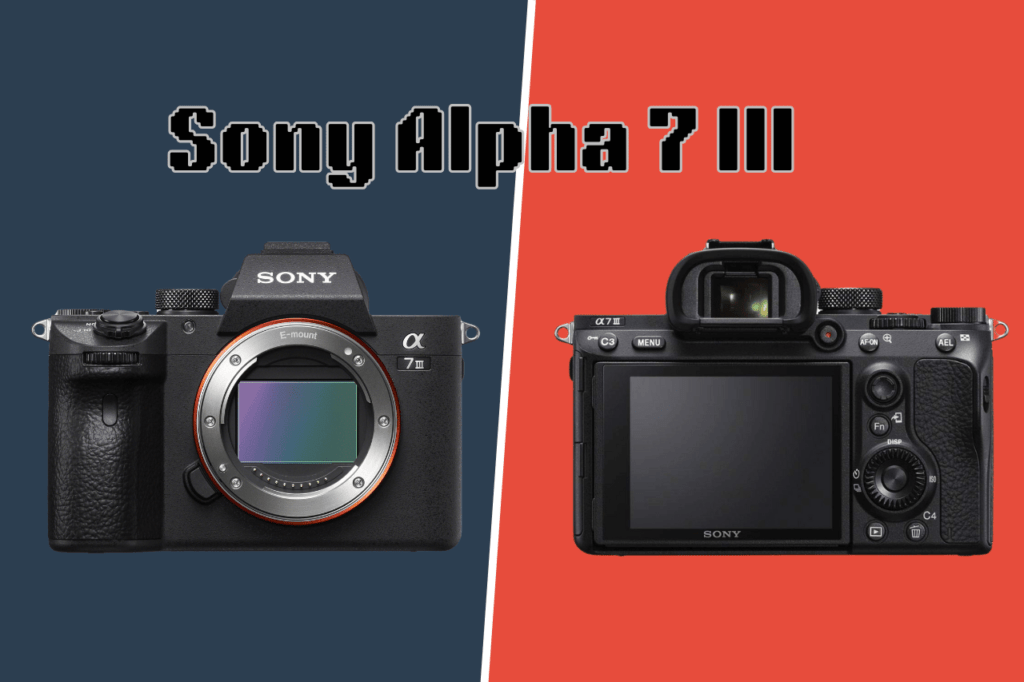
Sensor & Image Quality
- Sensor: 24.2-megapixel full-frame Exmor R BSI CMOS sensor
- Processor: BIONZ X image processor
- ISO Range: 100–51,200 (expandable to 50–204,800)
Autofocus & Burst Speed
- Autofocus: 693-point phase-detection and 425-point contrast-detection hybrid AF system
- Continuous Shooting: Up to 10 fps with mechanical or electronic shutter
Video Capabilities
- Recording:
- 4K UHD at 30p
- Full HD at 120p
- Additional Features: S-Log3 and HLG profiles for enhanced post-processing flexibility
Image Stabilization
- In-Body Image Stabilization (IBIS): 5-axis system providing up to 5 stops of compensation
Lens Ecosystem
- Mount: Sony E-mount, compatible with a wide range of Sony FE lenses
Ergonomics & Build
- Design: Weather-sealed body with dual SD card slots (one supports UHS-II)
- Viewfinder: 2.36-million-dot OLED electronic viewfinder
- Display: 3.0-inch tilting LCD screen with 922,000 dots
Battery Life
- Battery: NP-FZ100 Li-ion rechargeable battery
- Approximate Shots (CIPA Rating): 710 shots on a full charge
✔️What I like
- Full‑frame sensor with 15‑stop dynamic range
- Exceptional autofocus and IBIS
- Dual card slots and advanced features
❌What I don’t like
- 8‑bit video output only
Nikon Z6 Mark III
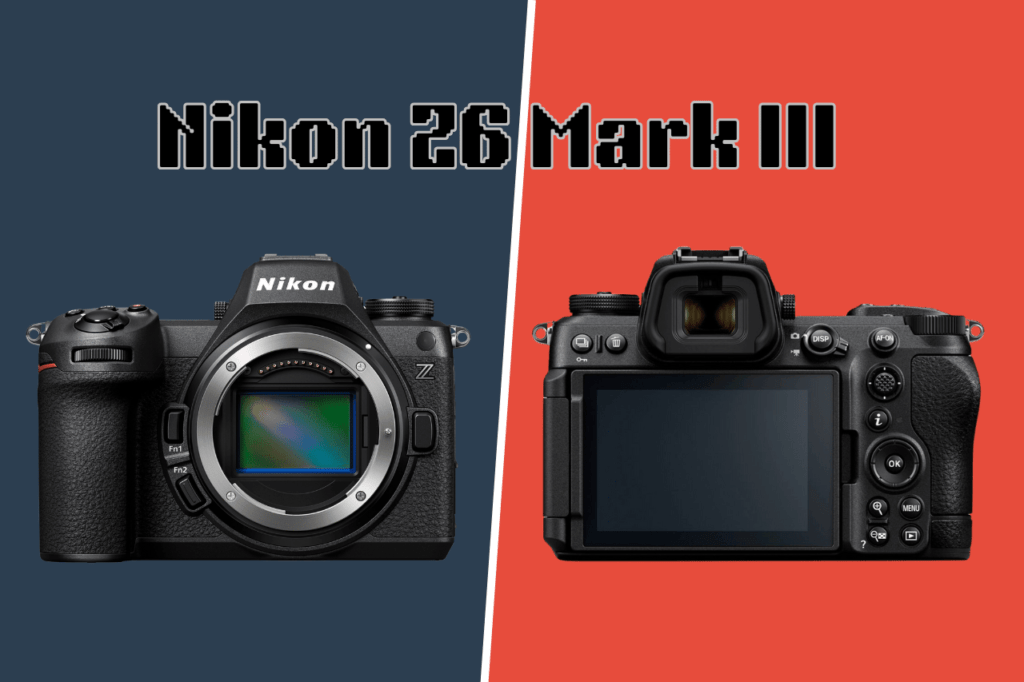
Sensor & Image Quality
- Sensor: 24.5-megapixel full-frame BSI (backside-illuminated) CMOS sensor
- Processor: EXPEED 7 image processor
- ISO Range: 100–64,000 (expandable to 50–204,800)
Autofocus & Burst Speed
- Autofocus: Hybrid AF system with 273 focus points (single-point AF) and 299 focus points (auto-area AF)
- Continuous Shooting: Up to 14 fps with mechanical shutter; up to 20 fps with electronic shutter
Video Capabilities
- Recording:
- 6K at 60p N-RAW and ProRes RAW
- 4K UHD at 60p
- Full HD at 240p for slow-motion
- Additional Features: Supports N-RAW, ProRes RAW HQ, ProRes 422 HQ, H.265, and H.264 codecs
Image Stabilization
- In-Body Image Stabilization (IBIS): 5-axis system providing up to 8 stops of compensation
Lens Ecosystem
- Mount: Nikon Z-mount, compatible with a wide range of Nikkor Z lenses
Ergonomics & Build
- Dimensions: Approx. 138.5 × 101.5 × 74 mm (5.5 × 4 × 3 in.)
- Weight: Approx. 760 g with battery and memory card
- Design: Weather-sealed body with dust and moisture resistance; operational down to -10°C
- Viewfinder: 5.76-million-dot OLED electronic viewfinder with up to 4,000 nits brightness
- Display: 3.2-inch fully articulating LCD screen with 2.1 million dots
Battery Life
- Battery: EN-EL15c rechargeable battery
- Approximate Shots (CIPA Rating): Up to 380 shots on a full charge
✔️What I like
- Very good image quality
- Reliable AF tracking with subject recognition
- Extensive video resolution and codec options
❌What I don’t like
- Peak dynamic range is a touch lower than peers
- Limited support for n‑Raw video
- Nikon’s strict third‑party lens options
Canon EOS R6 II
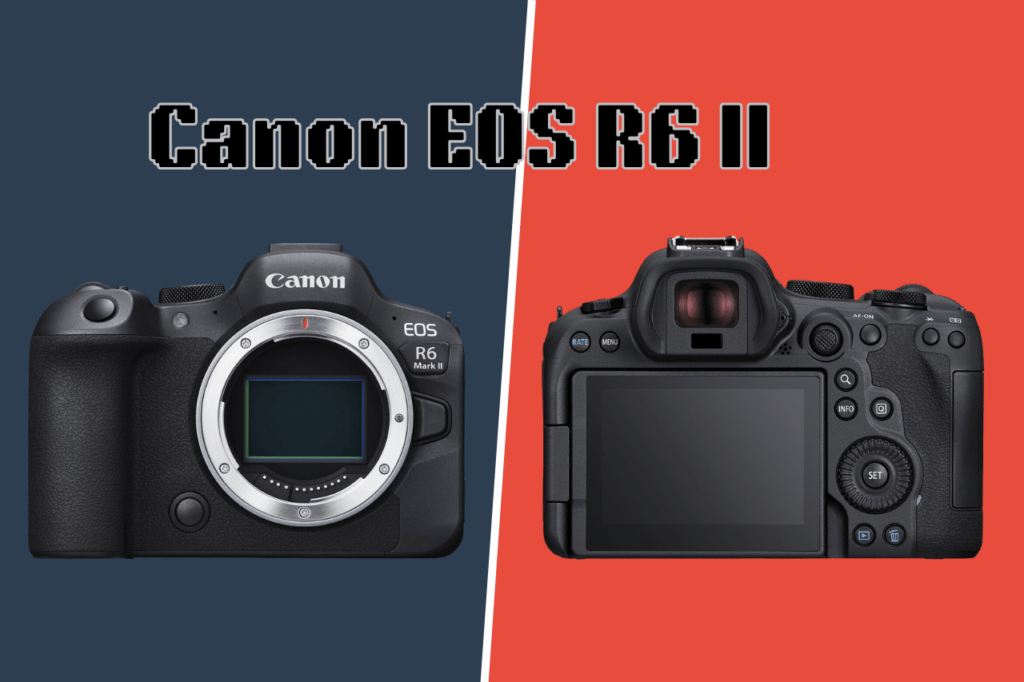
Sensor & Image Quality
- Sensor: 24.2-megapixel full-frame CMOS sensor
- Processor: DIGIC X image processor
- ISO Range: 100–102,400 (expandable to 50–204,800)
Autofocus & Burst Speed
- Autofocus: Dual Pixel CMOS AF II with 1,053 AF points citeturn0search1
- Continuous Shooting: Up to 12 fps with mechanical shutter; up to 40 fps with electronic shutter
Video Capabilities
- Recording:
- 4K UHD at 60p
- Full HD at 180p for slow-motion
- Additional Features: Supports 10-bit 4:2:2 internal recording
Image Stabilization
- In-Body Image Stabilization (IBIS): 5-axis system providing up to 8 stops of compensation
Lens Ecosystem
- Mount: Canon RF-mount, compatible with a wide range of RF lenses
Ergonomics & Build
- Dimensions: Approx. 138.4 × 98.4 × 88.4 mm
- Weight: Approx. 588 g (body only)
- Design: Weather-sealed body with dust and moisture resistance
- Viewfinder: 3.69-million-dot OLED electronic viewfinder
- Display: 3.0-inch fully articulating LCD screen
Battery Life
- Battery: LP-E6NH rechargeable battery
- Approximate Shots (CIPA Rating): Up to 320 shots on a full charge with the viewfinder and 580 shots using the rear LCD
✔️What I like
- Simple, powerful AF for stills
- Fast 40fps continuous shooting
- Excellent battery life
❌What I don’t like
- AF in video mode can be inconsistent
- Burst shooting limited by SD card speeds
- E‑shutter may distort fast subjects
Canon EOS R8
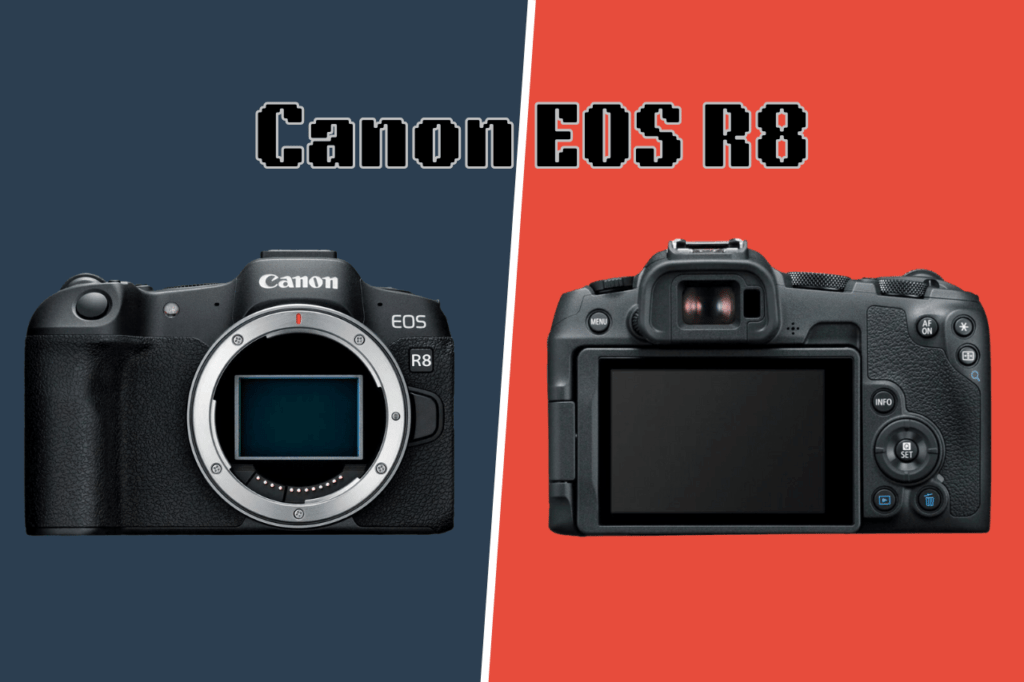
Sensor & Image Quality
- Sensor: 24.2-megapixel full-frame CMOS sensor
- Processor: DIGIC X image processor
- ISO Range: 100–102,400 (expandable to 50–204,800)
Autofocus & Burst Speed
- Autofocus: Dual Pixel CMOS AF II with up to 1,053 AF zones
- Continuous Shooting: Up to 6 fps with electronic first-curtain shutter; up to 40 fps with electronic shutter
Video Capabilities
- Recording:
- 4K UHD at 60p (oversampled from 6K)
- Full HD at 180p for slow-motion
- Additional Features: Supports 10-bit 4:2:2 internal recording with Canon Log 3 and HDR PQ
Image Stabilization
- Stabilization: No in-body image stabilization (IBIS); supports lens-based optical IS and Movie Digital IS
Lens Ecosystem
- Mount: Canon RF mount, compatible with a wide range of RF lenses; EF and EF-S lenses compatible via mount adapter
Ergonomics & Build
- Dimensions: Approx. 132.5 × 86.1 × 70.0 mm
- Weight: Approx. 461 g with battery and memory card
- Design: Compact and lightweight body with a vari-angle touchscreen LCD
- Viewfinder: 2.36-million-dot OLED electronic viewfinder
- Display: 3.0-inch vari-angle LCD with 1.62 million dots
Battery Life
- Battery: LP-E17 rechargeable battery
- Approximate Shots (CIPA Rating): Approx. 150 shots per charge
✔️What I like:
- Consistently excellent image quality
- Capable autofocus and fast burst shooting
- Flexibility to adapt EF lenses
❌What I don’t like
- No in‑body stabilization
- Battery life is not the best
Nikon Z7 Mark II

This camera is a little over $2000.

But, you can find a good deal on different websites for less than this price. As for why I included it, well, its performance is worth it.
Sensor & Image Quality
- Sensor: 45.7-megapixel full-frame (35.9 x 23.9 mm) CMOS sensor
- Processor: Dual EXPEED 6 image processors
- ISO Range: 64–25,600 (expandable to 32–102,400)
Autofocus & Burst Speed
- Autofocus: 493-point hybrid AF system covering approximately 90% of the frame
- Continuous Shooting: Up to 10 fps with full AF/AE
Video Capabilities
- Recording:
- 4K UHD at up to 60p
- Full HD at up to 120p
- Additional Features: Supports 10-bit 4:2:2 output over HDMI
Image Stabilization
- In-Body Image Stabilization (IBIS): 5-axis system providing up to 5 stops of compensation
Lens Ecosystem
- Mount: Nikon Z-mount, compatible with a wide range of NIKKOR Z lenses; F-mount lenses compatible via FTZ adapter
Ergonomics & Build
- Dimensions: Approx. 134 x 100.5 x 69.5 mm
- Weight: Approx. 705 g with battery and memory card
- Design: Robust magnesium alloy body with weather-sealing
- Viewfinder: 3.69-million-dot OLED electronic viewfinder
- Display: 3.2-inch tilting touchscreen LCD with 2.1 million dots
Battery Life
- Battery: EN-EL15c rechargeable Li-ion battery
- Approximate Shots (CIPA Rating): Up to 420 shots per charge
✔️What I like
- Deep buffer for continuous shooting
- Excellent high‑resolution image quality
- Intuitive, comfortable design
❌What I don’t like
- 4K/60p video comes with a 1.08x crop
- Some competitors offer faster autofocus
Nikon Zf
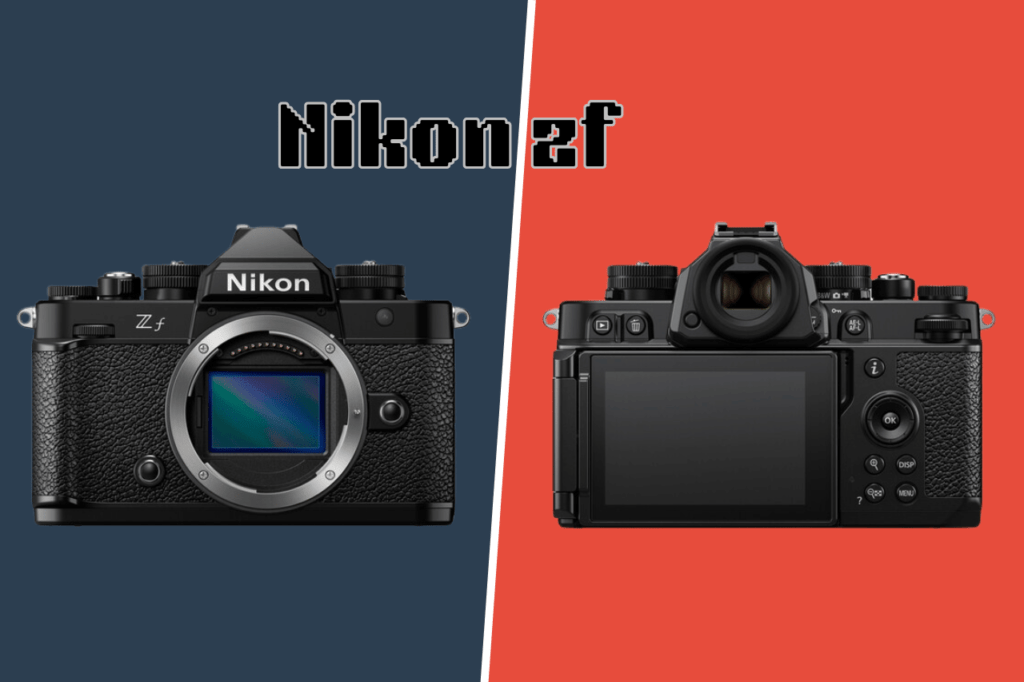
Sensor & Image Quality
- Sensor: 24.5-megapixel full-frame (35.9 x 23.9 mm) BSI-CMOS sensor
- Processor: EXPEED 7
- ISO Range: 100–64,000 (expandable to 50–204,800)
Autofocus & Burst Speed
- Autofocus: 273-point hybrid AF system
- Continuous Shooting: Up to 14 fps with mechanical shutter
Video Capabilities
- Recording:
- 4K UHD at up to 60p
- Full HD at up to 120p
Image Stabilization
- In-Body Image Stabilization (IBIS): 5-axis system providing up to 8 stops of compensation
Lens Ecosystem
- Mount: Nikon Z-mount, compatible with a wide range of NIKKOR Z lenses; F-mount lenses compatible via FTZ adapter
Ergonomics & Build
- Dimensions: Approx. 144 mm (W) x 101 mm (H) x 49 mm (D)
- Weight: Approx. 710 g with battery and memory card
- Design: Retro-inspired design reminiscent of Nikon’s classic FM2, with magnesium alloy body and brass top dials
- Viewfinder: 3.69-million-dot OLED electronic viewfinder
- Display: 3.2-inch vari-angle touchscreen LCD with 2.1 million dots
Battery Life
- Battery: EN-EL15c rechargeable Li-ion battery
- Approximate Shots (CIPA Rating): Up to 380 shots per charge
✔️What I like
- Distinctive design with tactile, direct controls
- Effective subject recognition
- Strong stills and video performance
❌What I don’t like
- Heavier body and less comfortable grip
- Slow MicroSD second slot
- Few customizable buttons
Sony Alpha 6700
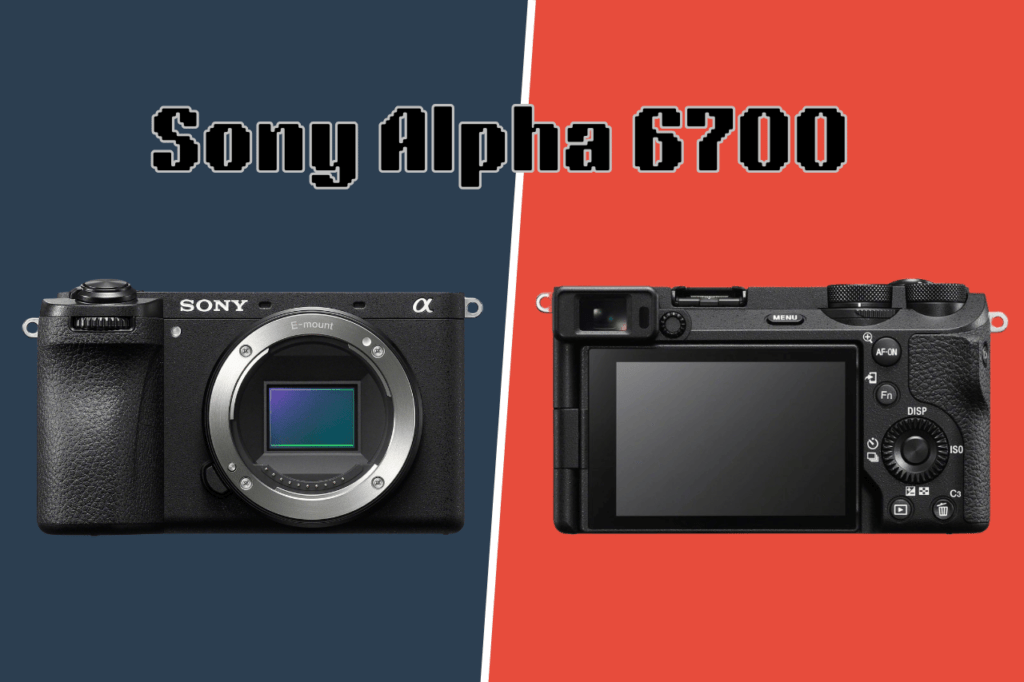
Sensor & Image Quality
- Sensor: 26.0-megapixel APS-C Exmor R™ back-illuminated CMOS sensor
- Processor: BIONZ XR™
- ISO Range: 100–32,000 (expandable to 50–102,400)
Autofocus & Burst Speed
- Autofocus: 759-point phase-detection AF system
- Continuous Shooting: Up to 11 fps with mechanical shutter
Video Capabilities
- Recording:
- 4K at up to 120p
- Full HD at up to 240p
Image Stabilization
- In-Body Image Stabilization (IBIS): 5-axis system
Lens Ecosystem
- Mount: Sony E-mount, compatible with a wide range of lenses
Ergonomics & Build
- Dimensions: Approx. 122 mm (W) x 69 mm (H) x 75 mm (D)
- Weight: Approx. 493 g with battery and memory card
- Design: Compact, weather-sealed body with a fully articulated 3.0-inch touchscreen LCD
Battery Life
- Battery: NP-FZ100 rechargeable Li-ion battery
- Approximate Shots (CIPA Rating): Up to 570 shots per charge using the LCD screen; up to 550 shots using the electronic viewfinder
✔️What I like
- Impressive AI‑powered autofocus
- Excellent 4K video up to 60p
- Compact and lightweight with direct controls
❌What I don’t like
- Complex menu system for beginners
- Video stabilization could be better
Fujifilm X-T5
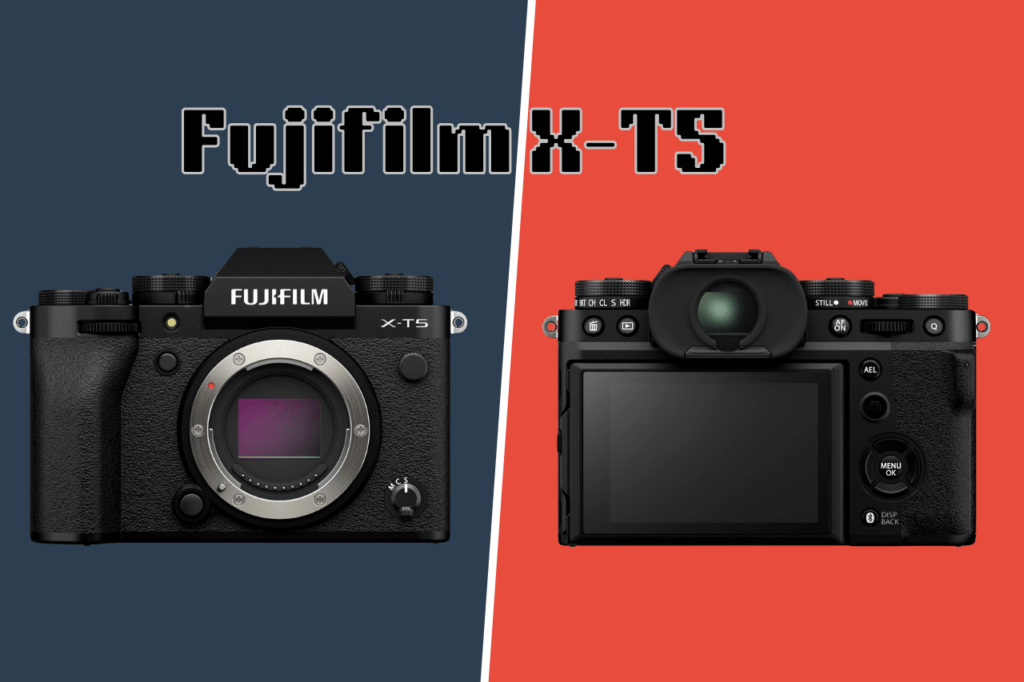
Sensor & Image Quality
- Sensor: 40.2-megapixel APS-C X-Trans CMOS 5 HR sensor
- Processor: X-Processor 5
- ISO Range: Auto, 125–12,800 (expandable to 64–51,200)
Autofocus & Burst Speed
- Autofocus: 425-point Intelligent Hybrid AF system
- Continuous Shooting: Up to 15 fps with mechanical shutter; up to 20 fps with electronic shutter
Video Capabilities
- Recording:
- 6.2K at 30p in 4:2:2 10-bit internally
- 4K at 60p
- Full HD at 240p for high-speed recording
Image Stabilization
- In-Body Image Stabilization (IBIS): 5-axis system providing up to 7 stops of stabilization
Lens Ecosystem
- Mount: Fujifilm X-mount, compatible with a wide range of Fujinon lenses
Ergonomics & Build
- Dimensions: 130mm (W) x 91mm (H) x 64mm (D)
- Weight: Approximately 557g with battery and memory card
- Design: Compact, lightweight body with a large grip and intuitive controls
Battery Life
- Battery: NP-W235 Li-ion battery
- Approximate Shots (CIPA Rating): Up to 740 shots per charge using the LCD screen; up to 600 shots using the electronic viewfinder
✔️What I like
- Ultra‑high-resolution sensor with stunning detail
- Excellent film simulations and color reproduction
- Competitive IBIS and robust video capabilities
❌What I don’t like
- EVF and LCD resolution lag behind some competitors
- AF can be less reliable in extreme sports or wildlife
- Slight learning curve with its retro controls
Fujifilm X-T50

Sensor & Image Quality
- Sensor: 40.2-megapixel APS-C X-Trans CMOS 5 HR sensor
- Processor: X-Processor 5
- ISO Range: 125–12,800 (expandable to 64–51,200)
Autofocus & Burst Speed
- Autofocus: Hybrid autofocus system with 425 phase-detection points
- Continuous Shooting: Up to 15 fps with mechanical shutter; up to 20 fps with electronic shutter
Video Capabilities
- Recording:
- 6.2K at 30p in 4:2:2 10-bit internally
- 4K at 60p
- Full HD at 240p for high-speed recording
Image Stabilization
- In-Body Image Stabilization (IBIS): 5-axis system providing up to 7 stops of stabilization
Lens Ecosystem
- Mount: Fujifilm X-mount, compatible with a wide range of Fujinon lenses
Ergonomics & Build
- Dimensions: 123.8mm (W) x 84.1mm (H) x 63.4mm (D)
- Weight: Approximately 438g with battery and memory card
- Design: Compact, lightweight body with a dedicated Film Simulation dial for quick access to various film emulations
Battery Life
- Battery: NP-W126S Li-ion battery
- Approximate Shots (CIPA Rating): Up to 305 photos on a full charge or 390 photos when using the camera’s battery-saving ‘Economy’ mode
✔️What I like
- Excellent image quality and Fujifilm film simulations
- Lightweight and portable
- Intuitive controls
❌What I don’t like
- No in‑body stabilization
- Autofocus can be slower in low‑light or fast‑action situations
Fujifilm X-S20

Sensor & Image Quality
- Sensor: 26.1-megapixel APS-C X-Trans CMOS 4
- Processor: X-Processor 5
- ISO Range: 160–12,800 (expandable to 80–51,200
Autofocus & Burst Speed
- Autofocus: 425-point Intelligent Hybrid AF system
- Continuous Shooting: Up to 8 fps with mechanical shutter; up to 20 fps with electronic shutter
Video Capabilities
- Recording:
- 6.2K at 30p in 4:2:2 10-bit internally
- 4K at 60p
- Full HD at 240p for high-speed recording
Image Stabilization
- In-Body Image Stabilization (IBIS): 5-axis system providing up to 7 stops of stabilization
Lens Ecosystem
- Mount: Fujifilm X-mount, compatible with a wide range of Fujinon lenses
Ergonomics & Build
- Dimensions: 127.7mm (W) x 85.1mm (H) x 65.4mm (D)
- Weight: Approximately 491g with battery and memory card
- Design: Compact, lightweight body with a large grip and intuitive controls
Battery Life
- Battery: NP-W235 Li-ion battery
- Approximate Shots (CIPA Rating): Up to 750 shots in normal mode and 800 in its power-saving economy mode
✔️What I like
- Improved AF performance
- Robust 4K video recording
- Compact, stylish design
❌What I don’t like
- Priced higher than basic models
- May lack some advanced pro‑level features
Sony Alpha 7C II

Sensor & Image Quality
- Sensor: 33‑megapixel full‑frame Exmor R CMOS sensor
- Processor: BIONZ XR processing engine
- ISO Range: Approximately 100–51,200 (expandable to 50–204,800)
Autofocus & Burst Speed
- Autofocus: Advanced Fast Hybrid AF with Real-time Eye AF for humans and animals, utilizing hundreds of phase-detection points
- Continuous Shooting: Up to 11 fps with the mechanical shutter
Video Capabilities
- Recording:
- 4K video recording at up to 30p (oversampled from a higher resolution for improved detail)
- Full HD recording at up to 120p for slow-motion capture
- Additional Features: 10‑bit 4:2:2 internal recording and S‑Log3 profiles for enhanced post‑production flexibility
Image Stabilization
- In-Body Image Stabilization (IBIS): 5‑axis IBIS offering up to 5 stops of stabilization to help counteract camera shake
Lens Ecosystem
- Mount: Sony E‑mount, compatible with a wide range of Sony and third‑party lenses
Ergonomics & Build
- Dimensions: Compact, designed for portability while maintaining a robust build
- Weight: Approximately 465 g (with battery and memory card)
Battery Life
- Battery: NP‑FZ100 rechargeable Li‑ion battery
- Approximate Shots (CIPA Rating): Around 740 shots per charge using the LCD monitor
✔️What I like
- Big features in a compact, lightweight body
- Outstanding AF performance
- Auto Framing video mode
❌What I don’t like
- No joystick control
- Lacks a fully mechanical shutter
Fujifilm X100VI

Sensor & Image Quality
- Sensor: 26.1‑megapixel APS‑C X‑Trans CMOS 5 sensor
- Processor: X‑Processor 5
- ISO Range: 125–12,800 (expandable to 64–51,200)
Autofocus & Performance
- Autofocus: 425‑point hybrid AF system with enhanced real‑time tracking and improved low‑light performance
Video Capabilities
- Recording:
- 6.2K at 30p in 4:2:2 10‑bit internal recording
- 4K at 60p
- Full HD at 240p for high‑speed recording
Image Stabilization
- In‑Body Image Stabilization (IBIS): 5‑axis system providing up to 7 stops of stabilization
Ergonomics & Build
- Hybrid Viewfinder: Combines an optical viewfinder with an electronic overlay for real‑time exposure and focus feedback
- Design: Classic retro‑inspired design updated with modern ergonomics and weather‑sealing
Battery Life
- Battery: NP‑W235 Li‑ion battery
- Approximate Shots (CIPA Rating): Up to approximately 740 shots per charge
✔️What I like
- Excellent build quality and retro design
- Effective subject‑detection autofocus
- In‑body image stabilization now included
❌What I don’t like
- Fixed lens focuses slower than some interchangeable options
- Hard to find in stock at times
Panasonic Lumix S5 II
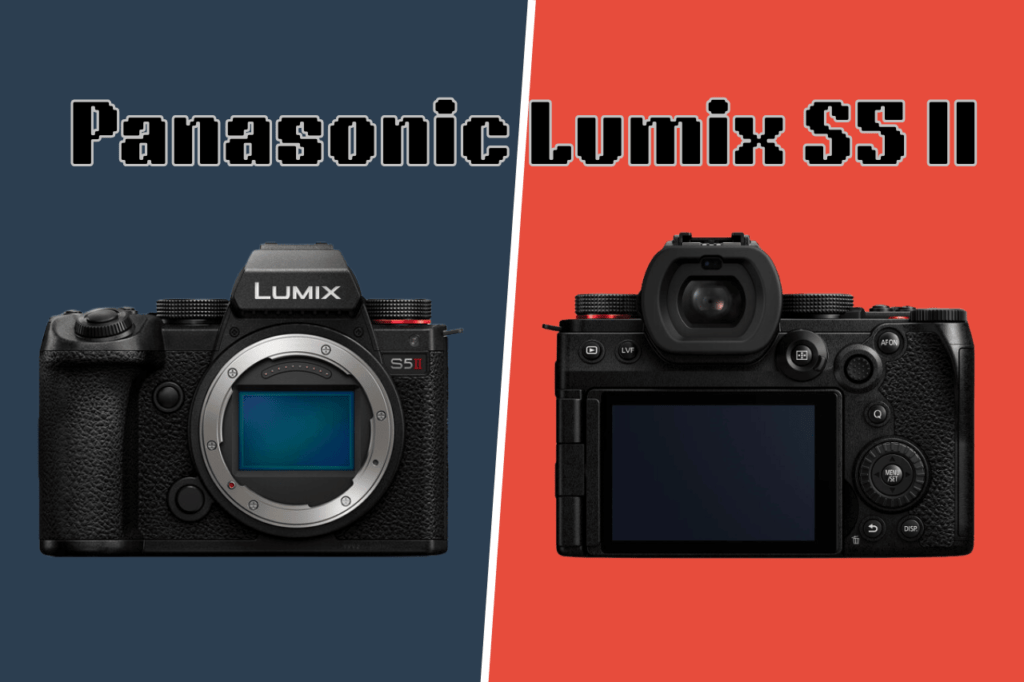
Sensor & Image Quality
- Sensor: 24.2‑megapixel full‑frame CMOS sensor
- Processor: Venus Engine
- ISO Range: Native range of 100–51,200 (with extended settings available)
Autofocus & Burst Speed
- Autofocus: Employs a contrast-detect AF system enhanced by Depth From Defocus (DFD) technology for fast and accurate focus
- Continuous Shooting: Up to approximately 10 fps with the electronic shutter
Video Capabilities
- Recording:
- 4K video in 10‑bit internally at up to 60p
- Full HD recording at up to 180p for slow‑motion capture
- Supports V‑Log/V‑Gamut for expanded dynamic range in post‑production
Image Stabilization
- In‑Body Image Stabilization (IBIS): 5‑axis stabilization providing up to 6 stops of compensation to counteract camera shake
Lens Ecosystem
- Mount: L‑mount, which is compatible with Panasonic, Leica, and Sigma lenses
Ergonomics & Build
- Design: Robust, weather‑sealed body designed for both stills and video, maintaining a compact form factor
- Dimensions & Weight: Comparable to its predecessor, roughly around 714 g (body only)
Battery Life
- Battery: DMW‑BLK22 rechargeable battery pack
- Approximate Shots (CIPA Rating): Approximately 370 shots per charge
✔️What I like
- Superb phase‑detection autofocus
- Unlimited 4K video recording
- Fast burst shooting with a deep buffer
❌What I don’t like
- Lacks a CFExpress slot
- Default JPEGs may appear dull without post‑processing
Nikon Z50 Mark II
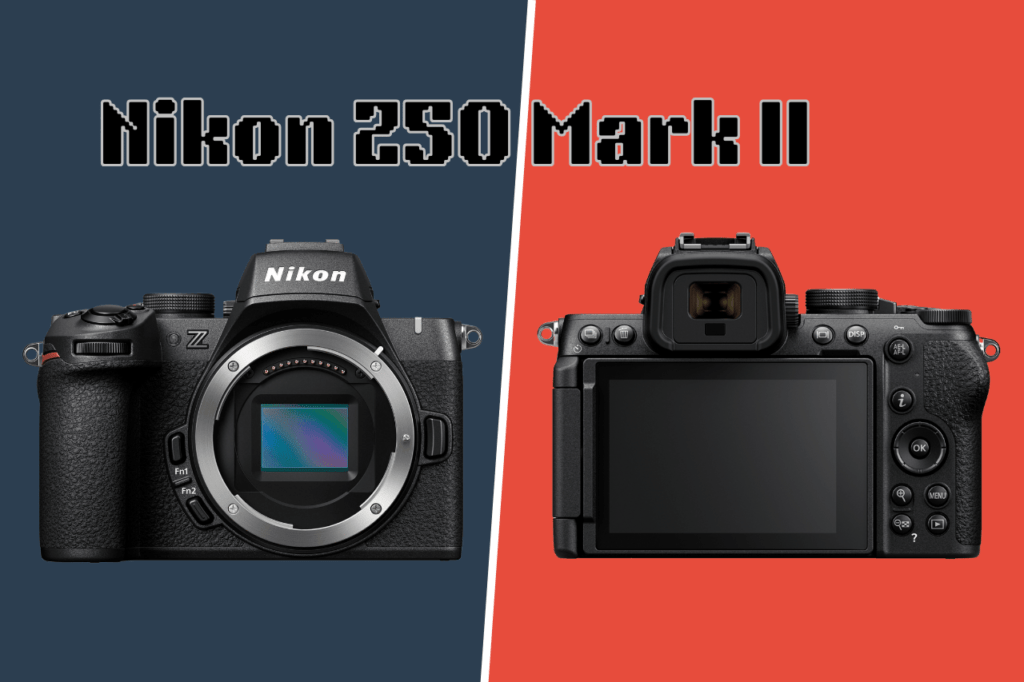
Sensor & Image Quality
- Sensor: 20.9-megapixel APS-C (DX) CMOS sensor
- Processor: EXPEED 7 image processor
- ISO Range: 100–51,200 (expandable to 204,800)
Autofocus & Burst Speed
- Autofocus: Enhanced 3D tracking system capable of detecting and tracking nine different subject types, including people, animals, and vehicles
- Continuous Shooting: Up to 30 frames per second (fps) with the electronic shutter; up to 11 fps with the mechanical shutter
Video Capabilities
- Recording Options:
- 4K UHD up to 60p (with a crop)
- Full HD up to 120p
- Additional Features: 10-bit N-Log recording, HLG support, and a “Product Review Mode” that shifts focus to foreground objects
Image Stabilization
- In-Body Image Stabilization (IBIS): The Z50II does not feature IBIS; it relies on lens-based stabilization (VR) for supported lenses.
Lens Ecosystem
- Mount: Nikon Z-mount, compatible with a wide range of Nikon and third-party lenses
Ergonomics & Build
- Dimensions & Weight: Approximately 127 x 97 x 67 mm; 550 grams (with battery and memory card)
- Design: Compact and lightweight with a solid grip, providing a balanced feel even with larger lenses
Battery Life
- Battery: EN-EL25a rechargeable Li-ion battery
- Approximate Shots (CIPA Rating): Approximately 250 shots per charge using the rear screen and 230 shots using the viewfinder
✔️What I like
- Feature‑rich APS‑C sensor with fast shooting
- 4K video up to 60p in 10‑bit log
- User‑friendly interface and solid build
❌What I don’t like
- Single card slot
- Third‑party lenses may not offer stabilization
- 4K60 mode is cropped
Sony Alpha ZV-E1

Sensor & Image Quality
- Sensor: 12.1-megapixel full-frame Exmor R CMOS sensor
- Processor: BIONZ XR image processor
- ISO Range: 80–102,400 (expandable to 40–409,600)
Autofocus & Burst Speed
- Autofocus: Fast Hybrid AF system with 759 phase-detection points and real-time Eye AF for humans and animals
- Continuous Shooting: Up to 10 frames per second with the electronic shutter
Video Capabilities
- Recording:
- 4K video up to 60p without crop
- Full HD (1080p) up to 120p
- Additional Features: 10-bit 4:2:2 internal recording, S-Log3, and HLG profiles for enhanced post-production flexibility
A future firmware update is expected to enable 4K recording at 120p.
Image Stabilization
- In-Body Image Stabilization (IBIS): 5-axis sensor-shift stabilization
Lens Ecosystem
- Mount: Sony E-mount, compatible with a wide range of Sony and third-party lenses
Ergonomics & Build
- Dimensions & Weight: Approximately 483 grams (including battery)
- Design: Compact and lightweight with a vari-angle LCD touchscreen, ideal for vloggers and content creators
Battery Life
- Battery: NP-FZ100 rechargeable lithium-ion battery
- Approximate Shots (CIPA Rating): Around 570 shots per charge using the LCD monitor
✔️What I like
- 4K video up to 120p
- Auto‑cropped modes simplify vlogging
- Effective autofocus
❌What I don’t like
- Short recording times in high temperatures
- 12MP sensor limits still image quality
- 4K output is cropped and upscaled
Sony Alpha 6600
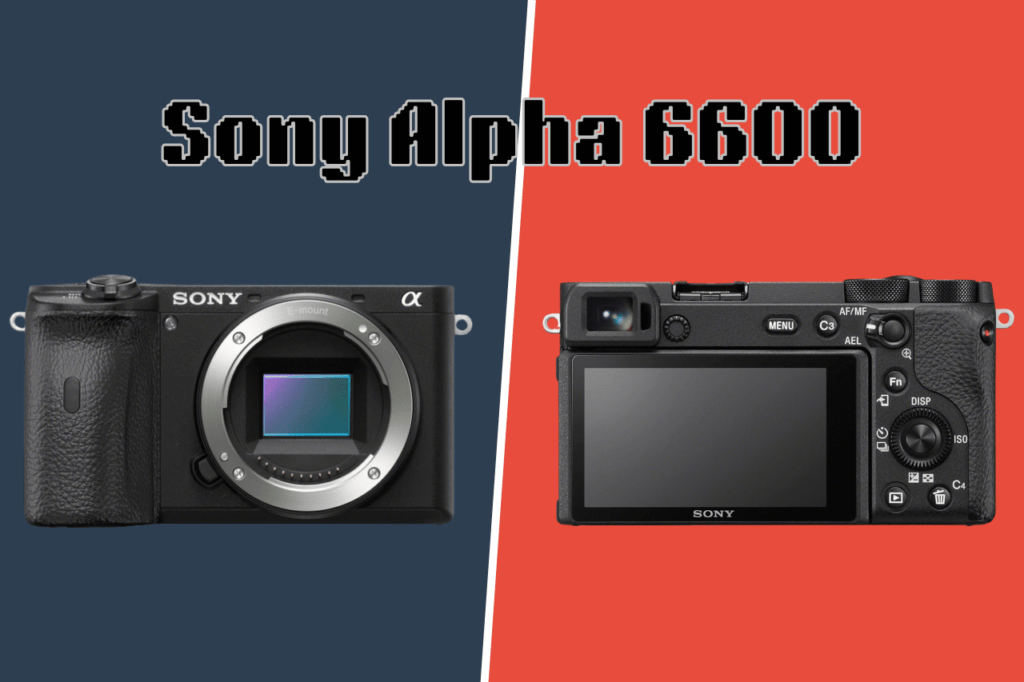
Sensor & Image Quality
- Sensor: 24.2-megapixel APS-C Exmor CMOS sensor
- Processor: BIONZ X image processor
- ISO Range: 100–32,000 (expandable to 50–102,400)
Autofocus & Continuous Shooting
- Autofocus System: Fast Hybrid AF with 425 phase-detection and 425 contrast-detection points
- Continuous Shooting: Up to 11 frames per second
Video Capabilities
- Recording:
- 4K UHD up to 30p with full pixel readout and no pixel binning
- Full HD 1080p up to 120p for slow-motion recording
- Additional Features: S-Log2 and S-Log3 gamma profiles for enhanced dynamic range and color grading flexibility
Image Stabilization
- In-Body Image Stabilization (IBIS): 5-axis sensor-shift stabilization
Lens Compatibility
- Mount: Sony E-mount
Ergonomics & Build
- Dimensions: Approximately 120 x 66.9 x 69.3 mm
- Weight: Approximately 503 grams (including battery and memory card)
- Construction: Magnesium alloy body with dust and moisture resistance
Battery Life
- Battery: NP-FZ100 rechargeable lithium-ion battery
- Approximate Shots (CIPA Rating): Around 720 shots per charge using the viewfinder, and up to 810 with the rear LCD monitor
✔️What I like
- Excellent battery life and reliable AF
- Solid still and video performance
- Robust build quality
❌What I don’t like
- Bulky design compared to newer, more compact models
- Lacks some modern interface refinements
Fujifilm X-M5
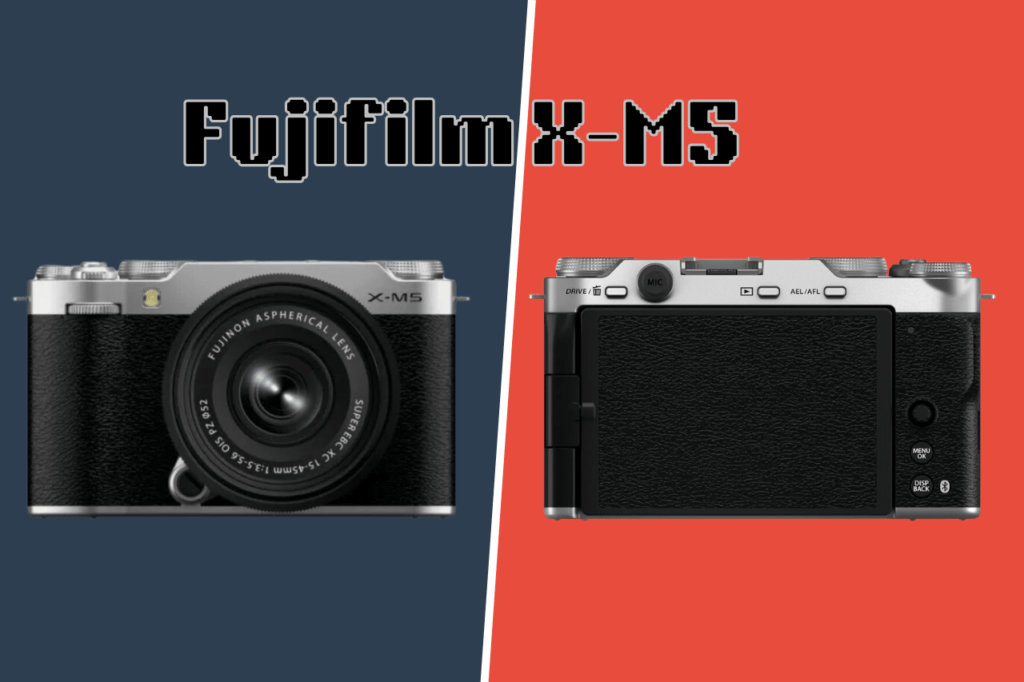
Sensor & Image Quality
- Sensor: 26.1-megapixel APS-C CMOS sensor
- Processor: X-Processor 5
- ISO Range: Not specified in the provided sources
Autofocus & Continuous Shooting
- Autofocus System: AI-driven subject detection autofocus, similar to that found in the FUJIFILM X100VI and X-T50 models
- Continuous Shooting: Up to 8fps (30fps with E-shutter and 1.25x crop)
Video Capabilities
- Recording:
- 6.2K video at up to 29.97 fps
- 4K video at 30p and 24p
- Full HD (1080p) at up to 120 fps for slow-motion recording
- Additional Features: 10-bit 4:2:2 internal recording, 9:16 vertical video mode for social media content
Image Stabilization
- In-Body Image Stabilization (IBIS): Not available
Lens Compatibility
- Mount: Fujifilm X-mount
Ergonomics & Build
- Dimensions & Weight: Approximately 13 ounces (about 368 grams)
- Design: Compact and lightweight with a fully articulating rear LCD, dedicated dial for film simulations, and a new three-mic system for improved audio recording
Battery Life
- Battery: Wh NP-W126s battery
- Approximate Shots (CIPA Rating): Up to 330 frames per full charge
✔️What I like
- High‑resolution sensor with excellent color reproduction
- 7 stops of IBIS
- Good battery life and hybrid video features
❌What I don’t like
- Rear screen only tilts, not fully articulating
- EVF and LCD resolution could be better
- AF can struggle with fast-moving subjects
Nikon Zfc
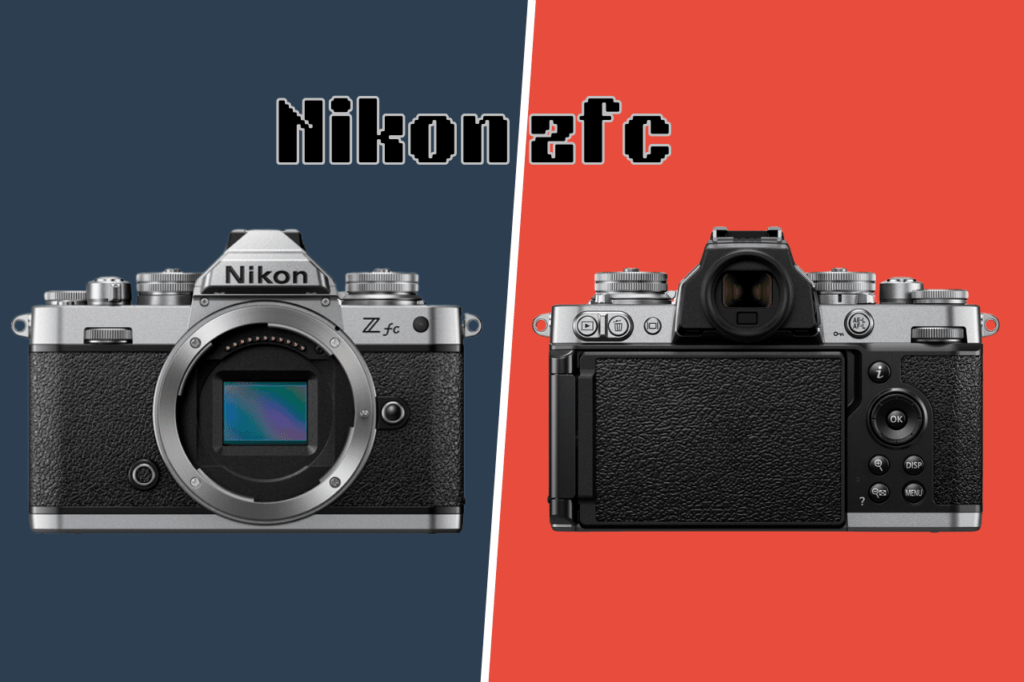
Sensor & Image Quality
- Sensor: 20.9‑megapixel APS‑C CMOS sensor
- Processor: EXPEED 6 image processor
- ISO Range: 100–51,200 (expandable to 204,800)
Autofocus & Burst Speed
- Autofocus: Hybrid AF system offering fast and accurate focusing performance (comparable to the Nikon Z50)
- Continuous Shooting: Up to 11 fps with the mechanical shutter
Video Capabilities
- Recording:
- 4K UHD video recording at up to 30p
- Full HD video recording at up to 120p for slow‑motion capture
- Additional Features: Provides standard video profiles for straightforward shooting without advanced log formats
Image Stabilization
- In‑Body Image Stabilization (IBIS): Not available; stabilization is achieved through VR‑enabled lenses
Lens Ecosystem
- Mount: Nikon Z‑mount for APS‑C (DX) cameras, compatible with a wide range of Nikon and third‑party lenses
Ergonomics & Build
- Design: Retro‑inspired design reminiscent of classic Nikon film cameras, featuring dedicated control dials and a tilting touchscreen LCD
- Dimensions & Weight: Compact and lightweight, with a body-only weight of approximately 445 grams
Battery Life
- Battery: EN‑EL25a rechargeable Li‑ion battery
- Approximate Shots (CIPA Rating): Approximately 250 shots per charge when using the rear screen and about 230 shots when using the viewfinder
✔️What I like
- Nostalgic retro design with physical controls
- Approachable interface and good image quality
- Unique style that stands out
❌What I don’t like
- Limited customization options
- Grip comfort can be an issue over long sessions
- Smaller lens ecosystem than full‑frame systems
Nikon Z5
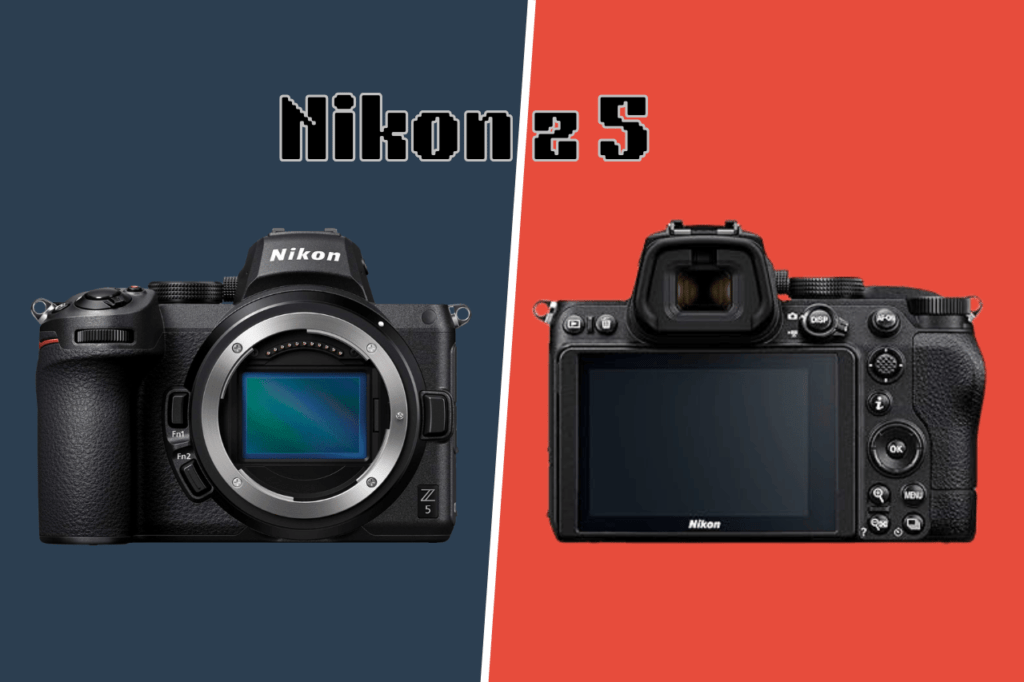
Sensor & Image Quality
- Sensor: 24.3‑megapixel full‑frame CMOS sensor
- Processor: EXPEED 6 image processor
- ISO Range: 100–51,200 (expandable to 50–204,800)
Autofocus & Burst Speed
- Autofocus: Hybrid AF system designed for reliable subject tracking
- Continuous Shooting: Up to 4.5 fps with the mechanical shutter and approximately 5 fps with the electronic shutter
Video Capabilities
- Recording:
- 4K UHD video recording at up to 30p (with a slight crop)
- Full HD video recording at up to 60p
- Additional Features: Includes features like focus peaking and microphone input for enhanced video production
Image Stabilization
- In‑Body Image Stabilization (IBIS): 5‑axis IBIS offering up to 5 stops of stabilization to help reduce camera shake
Lens Ecosystem
- Mount: Nikon Z‑mount, compatible with a wide range of Nikon and third‑party lenses
Ergonomics & Build
- Design: Retro‑inspired, compact, and robust with weather‑sealing
- Dimensions & Weight: Approximately 134 x 100 x 69 mm; around 675 grams (body only)
Battery Life
- Battery: EN‑EL15c rechargeable Li‑ion battery
- Approximate Shots (CIPA Rating): Approximately 470 shots per charge using the rear LCD and around 420 shots when using the viewfinder
✔️What I like
- Affordable full‑frame option
- Good image quality and build
- Effective IBIS
❌What I don’t like
- Slower burst rates and performance
- 4K video has limitations due to crop factors
Sigma fp

Sensor & Image Quality
- Sensor: 24.6‑megapixel full‑frame BSI‑CMOS sensor (35.9 mm x 23.9 mm)
- Processor: (Information not explicitly stated; relies on the sensor’s design and overall system performance)
- ISO Range: 100–25,600 (expandable to 6–102,400)
Autofocus & Burst Speed
- Autofocus: Contrast-detect AF system with 49 AF points; offers manual focus override and focus peaking
- Continuous Shooting: Up to 18 frames per second in burst mode
Video Capabilities
- Recording:
- Internal: UHD 4K video at up to 30p; Full HD video at up to 120p
- Supports 12‑bit CinemaDNG raw video (internal, when using an external recorder via USB-C)
- Additional Features: 10‑bit output via HDMI (with an external recorder), multiple video frame rate options
Image Stabilization
- Stabilization: The Sigma fp does not have built-in optical or in‑body image stabilization; stabilization must be achieved via compatible stabilized lenses or electronic methods in post
Lens Ecosystem
- Mount: Leica L‑mount; compatible with a range of L‑mount lenses and adaptable to other systems using appropriate adapters
Ergonomics & Build
- Design & Build:
- Compact and lightweight body measuring 112.6 x 69.9 x 45.3 mm
- Weight: Approximately 370 g (body only), 422 g with battery and SD card
- Constructed with a robust, die-cast aluminum alloy body featuring a heat sink and 42‑point sealing for dust and splash resistance
Battery Life
- Battery: Uses the Sigma BP-51 rechargeable lithium‑ion battery
- Approximate Shots (CIPA Rating): (CIPA ratings are not widely reported for the fp; typical usage estimates vary, but user reports suggest modest performance comparable to other compact full‑frame cameras)
✔️What I like
- 4K UHD with multiple professional codecs
- Excellent RAW output for computational photography
- Ultra‑compact size
❌What I don’t like
- No headphone jack
- Single card slot only
- Lacks in‑body stabilization
Comparison & Buying Guide Tips
After I’ve thrown all these cameras at you, let me help you get out of the mess I put you in. Let’s consider some things so that you can choose the right camera for you.
The first thing I will suggest is to balance your budget with the performance you want. Cameras such as the Nikon Z6 III or Canon EOS R6 II provide full-frame quality with excellent image performance, advanced video features, and quick shooting—all for under $2000.
For those on a tighter budget, APS‑C models like the Fujifilm X‑T5 offer high resolution and superb film simulations without the full-frame cost.
I would also recommend that you consider refurbished models because they can offer great value.
High‑performance cameras like the Canon EOS R6 II or Nikon Z6 III are sometimes available refurbished at a lower price, letting you get the features you need without overspending.
Another VERY important thing is to think long-term. If you plan to expand your lens collection, choose a system with a robust lens lineup. For example, Sony’s E‑mount and Canon’s RF mount both offer a wide range of native lenses and adapter options, so you can grow your kit over time.
Finally, ask yourself about your shooting style. If you’re into fast action or sports, cameras with excellent burst speeds and autofocus—like the Sony a7C II or Nikon Z6 III—are ideal.
For vloggers, the Sony ZV‑E1’s video-friendly design might be best, and if you love a retro vibe, the Nikon Z fc offers a classic look with modern performance.
Conclusion
To sum up, you can now choose between these cameras based on what we talked about. One last thing I would say is once you narrow your list to a few cameras, explore detailed reviews, test models in-store, and consider your long-term photography/videography goals to make the best choice. But, don’t overcomplicate it as the camera is just a tool to capture the beauty YOU see.
Remember: The best camera is the one you use confidently to tell your story!
